Analysis of HRM, Leadership Models, and Software Programs
VerifiedAdded on 2023/01/24
|6
|1354
|47
Report
AI Summary
This report provides a comprehensive analysis of Human Resource Management (HRM) and leadership principles. It begins by defining HRM models and then analyzes the HR function in relation to strategic human resource initiatives. The report explores the benefits of HRM software programs for organizations and discusses the characteristics of effective leaders and leadership models, specifically focusing on Fiedler's model. The report uses Whirlpool Company as a case study to illustrate these concepts. Furthermore, it covers various HRM functions such as recruitment, staff training, and compensation. It also highlights the importance of leadership traits in overcoming business challenges. The report concludes by emphasizing the significance of HRM in managing employees, company culture, and the overall environment. References to books and journals are included to support the analysis.
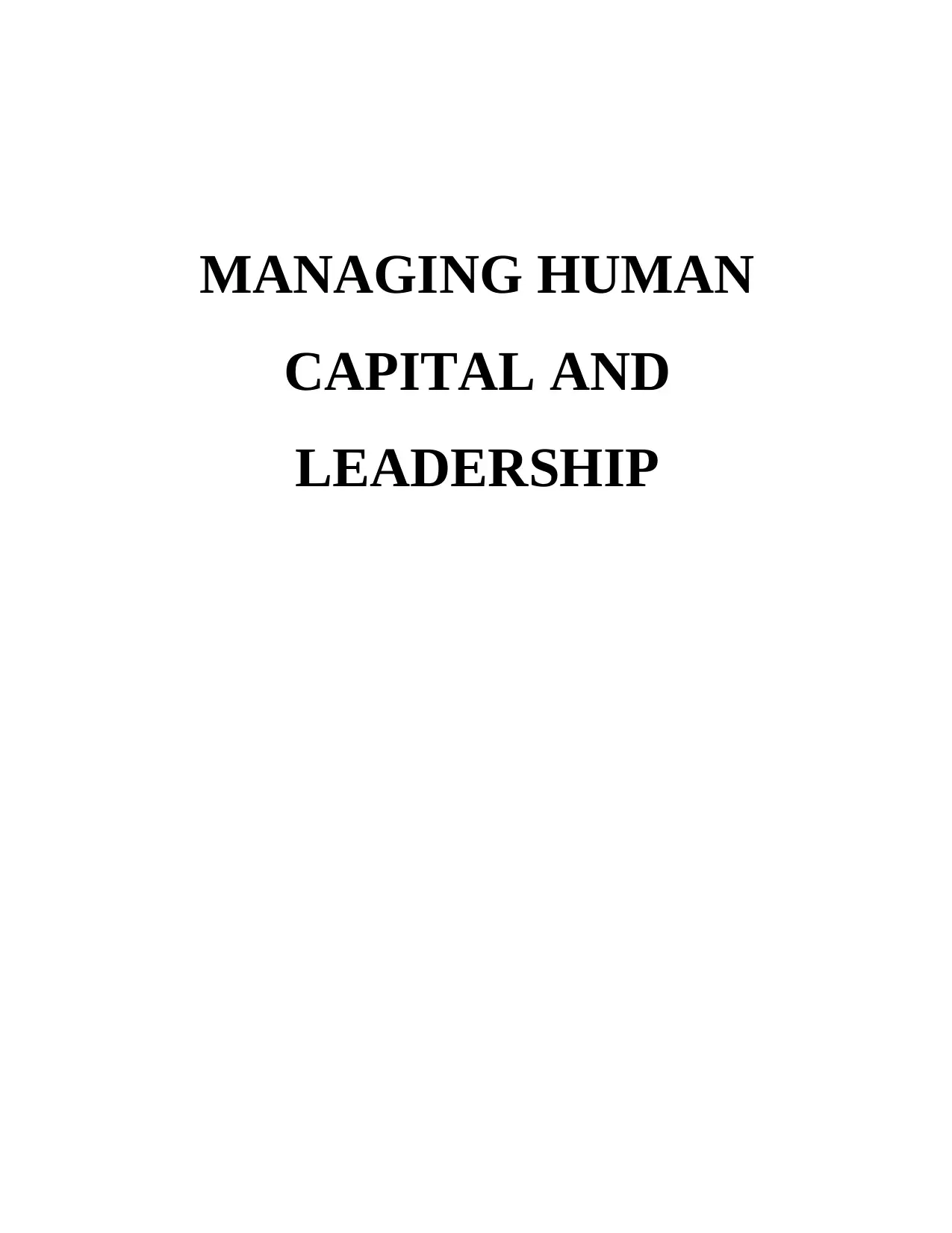
MANAGING HUMAN
CAPITAL AND
LEADERSHIP
CAPITAL AND
LEADERSHIP
Paraphrase This Document
Need a fresh take? Get an instant paraphrase of this document with our AI Paraphraser
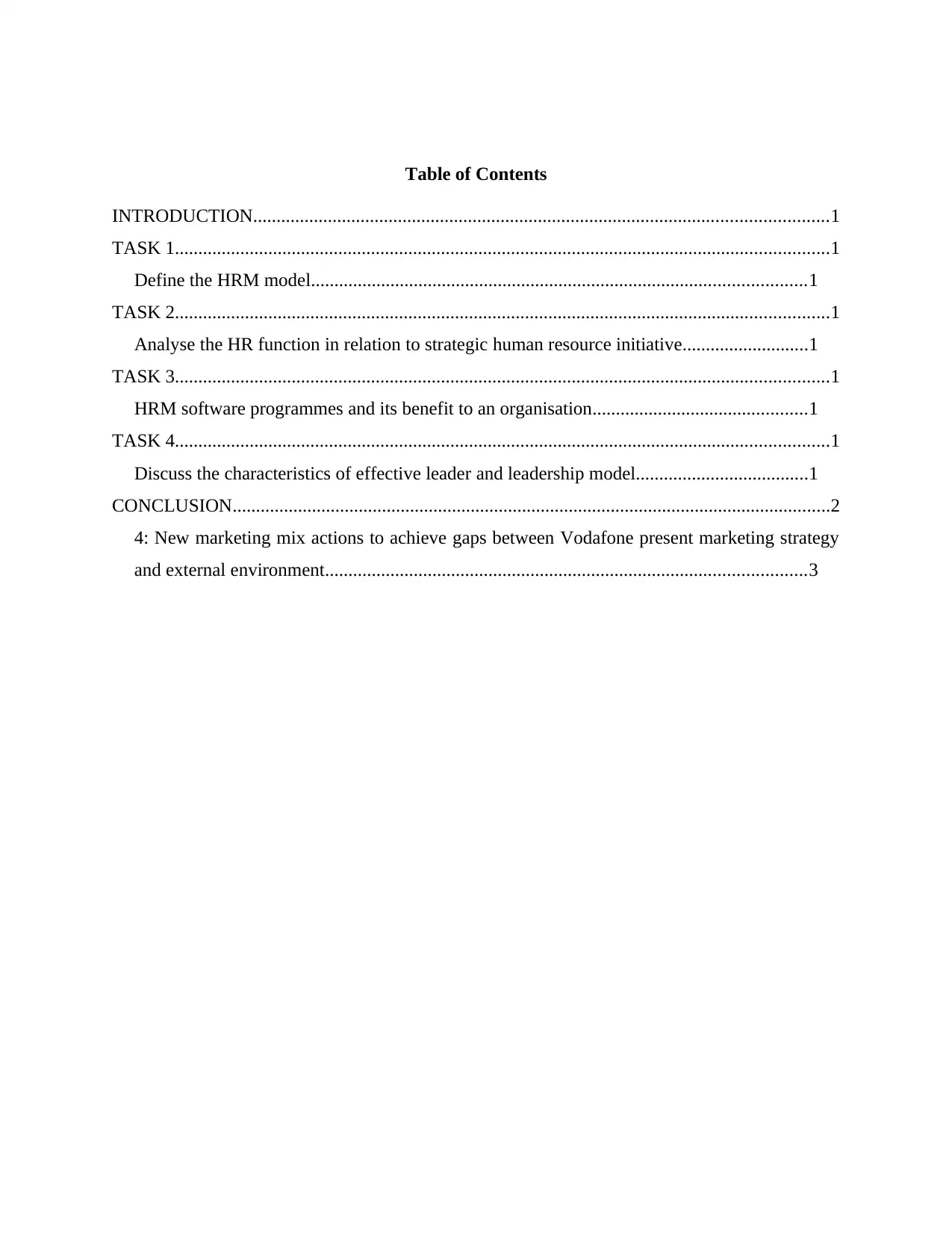
Table of Contents
INTRODUCTION...........................................................................................................................1
TASK 1............................................................................................................................................1
Define the HRM model..........................................................................................................1
TASK 2............................................................................................................................................1
Analyse the HR function in relation to strategic human resource initiative...........................1
TASK 3............................................................................................................................................1
HRM software programmes and its benefit to an organisation..............................................1
TASK 4............................................................................................................................................1
Discuss the characteristics of effective leader and leadership model.....................................1
CONCLUSION................................................................................................................................2
4: New marketing mix actions to achieve gaps between Vodafone present marketing strategy
and external environment.......................................................................................................3
INTRODUCTION...........................................................................................................................1
TASK 1............................................................................................................................................1
Define the HRM model..........................................................................................................1
TASK 2............................................................................................................................................1
Analyse the HR function in relation to strategic human resource initiative...........................1
TASK 3............................................................................................................................................1
HRM software programmes and its benefit to an organisation..............................................1
TASK 4............................................................................................................................................1
Discuss the characteristics of effective leader and leadership model.....................................1
CONCLUSION................................................................................................................................2
4: New marketing mix actions to achieve gaps between Vodafone present marketing strategy
and external environment.......................................................................................................3
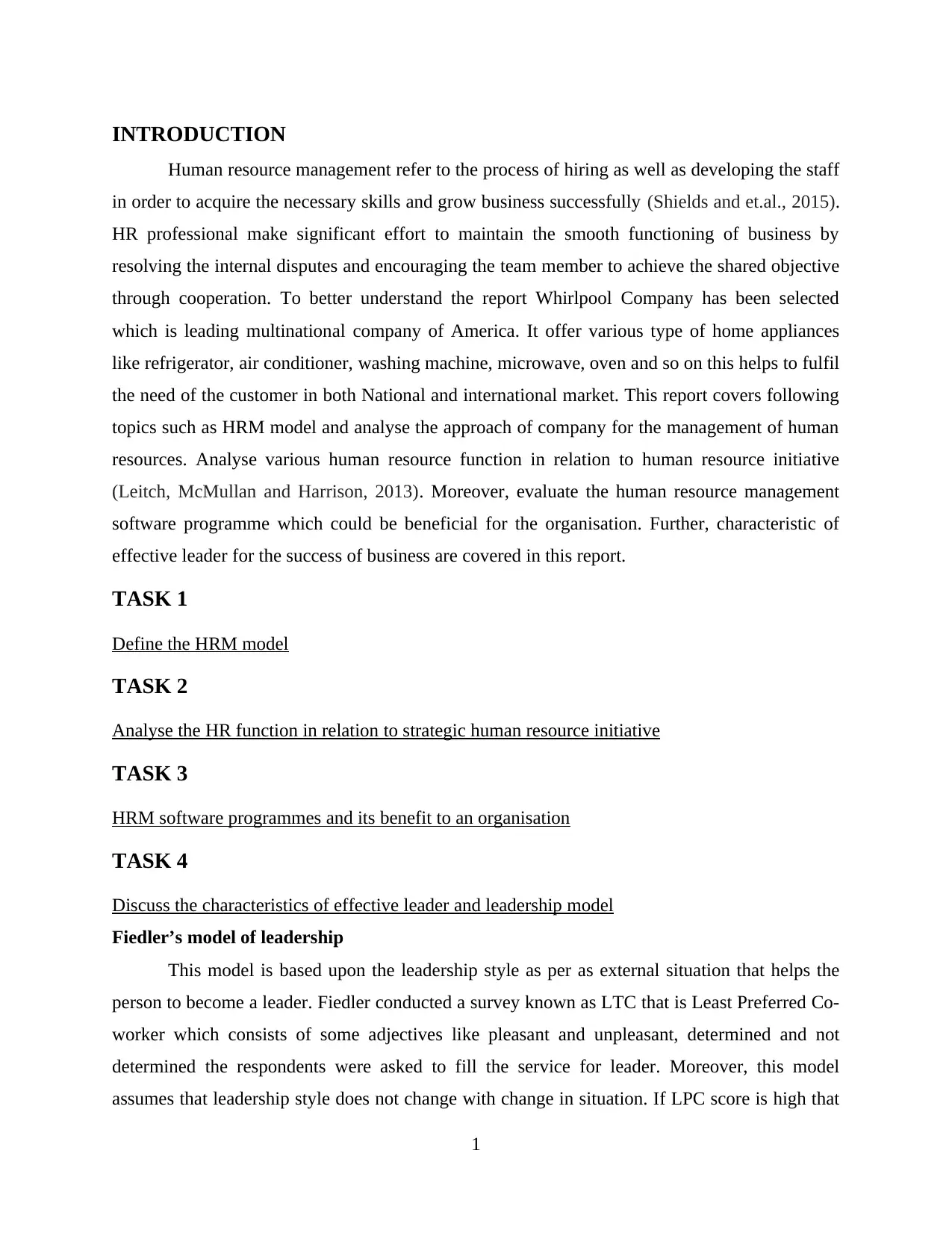
INTRODUCTION
Human resource management refer to the process of hiring as well as developing the staff
in order to acquire the necessary skills and grow business successfully (Shields and et.al., 2015).
HR professional make significant effort to maintain the smooth functioning of business by
resolving the internal disputes and encouraging the team member to achieve the shared objective
through cooperation. To better understand the report Whirlpool Company has been selected
which is leading multinational company of America. It offer various type of home appliances
like refrigerator, air conditioner, washing machine, microwave, oven and so on this helps to fulfil
the need of the customer in both National and international market. This report covers following
topics such as HRM model and analyse the approach of company for the management of human
resources. Analyse various human resource function in relation to human resource initiative
(Leitch, McMullan and Harrison, 2013). Moreover, evaluate the human resource management
software programme which could be beneficial for the organisation. Further, characteristic of
effective leader for the success of business are covered in this report.
TASK 1
Define the HRM model
TASK 2
Analyse the HR function in relation to strategic human resource initiative
TASK 3
HRM software programmes and its benefit to an organisation
TASK 4
Discuss the characteristics of effective leader and leadership model
Fiedler’s model of leadership
This model is based upon the leadership style as per as external situation that helps the
person to become a leader. Fiedler conducted a survey known as LTC that is Least Preferred Co-
worker which consists of some adjectives like pleasant and unpleasant, determined and not
determined the respondents were asked to fill the service for leader. Moreover, this model
assumes that leadership style does not change with change in situation. If LPC score is high that
1
Human resource management refer to the process of hiring as well as developing the staff
in order to acquire the necessary skills and grow business successfully (Shields and et.al., 2015).
HR professional make significant effort to maintain the smooth functioning of business by
resolving the internal disputes and encouraging the team member to achieve the shared objective
through cooperation. To better understand the report Whirlpool Company has been selected
which is leading multinational company of America. It offer various type of home appliances
like refrigerator, air conditioner, washing machine, microwave, oven and so on this helps to fulfil
the need of the customer in both National and international market. This report covers following
topics such as HRM model and analyse the approach of company for the management of human
resources. Analyse various human resource function in relation to human resource initiative
(Leitch, McMullan and Harrison, 2013). Moreover, evaluate the human resource management
software programme which could be beneficial for the organisation. Further, characteristic of
effective leader for the success of business are covered in this report.
TASK 1
Define the HRM model
TASK 2
Analyse the HR function in relation to strategic human resource initiative
TASK 3
HRM software programmes and its benefit to an organisation
TASK 4
Discuss the characteristics of effective leader and leadership model
Fiedler’s model of leadership
This model is based upon the leadership style as per as external situation that helps the
person to become a leader. Fiedler conducted a survey known as LTC that is Least Preferred Co-
worker which consists of some adjectives like pleasant and unpleasant, determined and not
determined the respondents were asked to fill the service for leader. Moreover, this model
assumes that leadership style does not change with change in situation. If LPC score is high that
1
⊘ This is a preview!⊘
Do you want full access?
Subscribe today to unlock all pages.

Trusted by 1+ million students worldwide
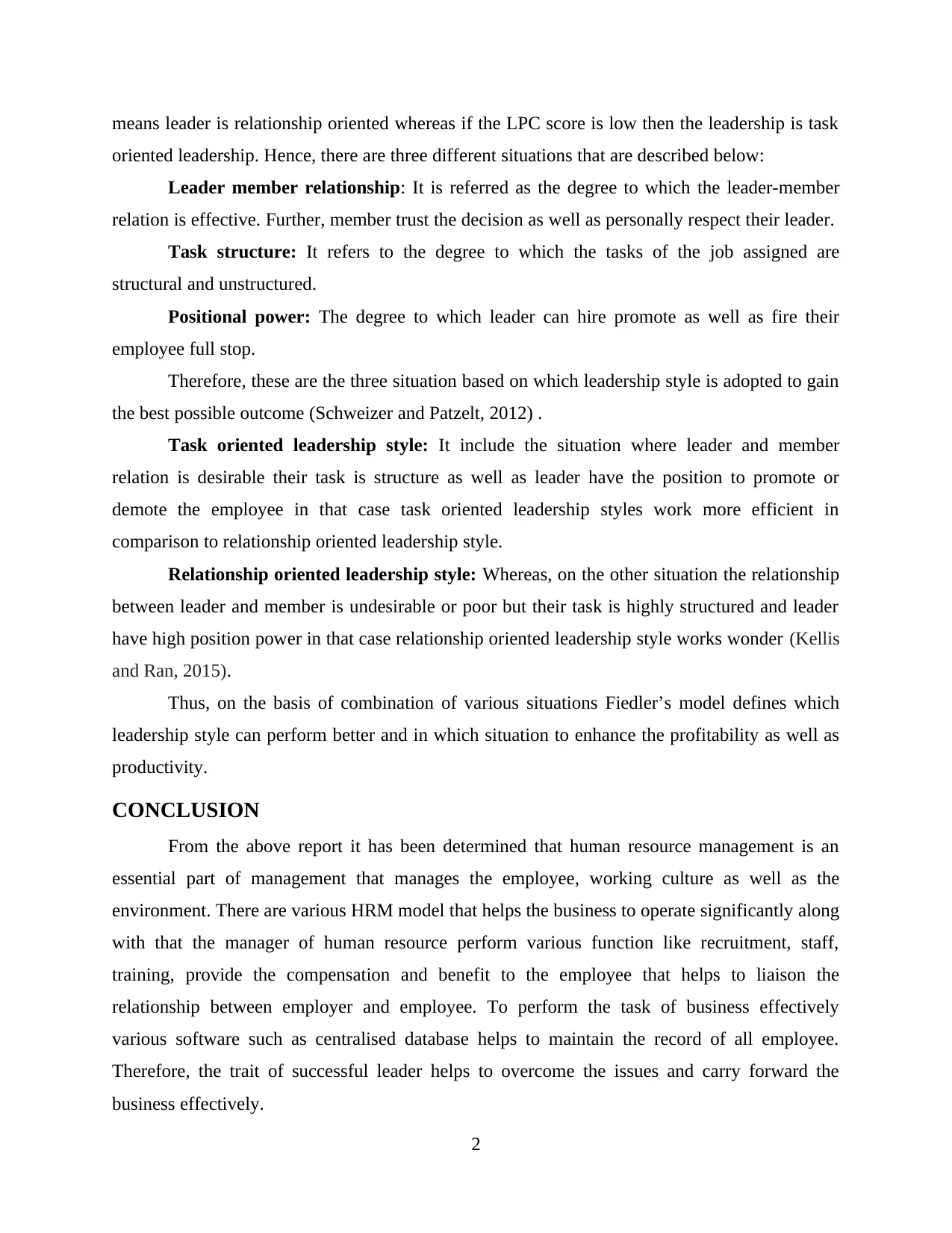
means leader is relationship oriented whereas if the LPC score is low then the leadership is task
oriented leadership. Hence, there are three different situations that are described below:
Leader member relationship: It is referred as the degree to which the leader-member
relation is effective. Further, member trust the decision as well as personally respect their leader.
Task structure: It refers to the degree to which the tasks of the job assigned are
structural and unstructured.
Positional power: The degree to which leader can hire promote as well as fire their
employee full stop.
Therefore, these are the three situation based on which leadership style is adopted to gain
the best possible outcome (Schweizer and Patzelt, 2012) .
Task oriented leadership style: It include the situation where leader and member
relation is desirable their task is structure as well as leader have the position to promote or
demote the employee in that case task oriented leadership styles work more efficient in
comparison to relationship oriented leadership style.
Relationship oriented leadership style: Whereas, on the other situation the relationship
between leader and member is undesirable or poor but their task is highly structured and leader
have high position power in that case relationship oriented leadership style works wonder (Kellis
and Ran, 2015).
Thus, on the basis of combination of various situations Fiedler’s model defines which
leadership style can perform better and in which situation to enhance the profitability as well as
productivity.
CONCLUSION
From the above report it has been determined that human resource management is an
essential part of management that manages the employee, working culture as well as the
environment. There are various HRM model that helps the business to operate significantly along
with that the manager of human resource perform various function like recruitment, staff,
training, provide the compensation and benefit to the employee that helps to liaison the
relationship between employer and employee. To perform the task of business effectively
various software such as centralised database helps to maintain the record of all employee.
Therefore, the trait of successful leader helps to overcome the issues and carry forward the
business effectively.
2
oriented leadership. Hence, there are three different situations that are described below:
Leader member relationship: It is referred as the degree to which the leader-member
relation is effective. Further, member trust the decision as well as personally respect their leader.
Task structure: It refers to the degree to which the tasks of the job assigned are
structural and unstructured.
Positional power: The degree to which leader can hire promote as well as fire their
employee full stop.
Therefore, these are the three situation based on which leadership style is adopted to gain
the best possible outcome (Schweizer and Patzelt, 2012) .
Task oriented leadership style: It include the situation where leader and member
relation is desirable their task is structure as well as leader have the position to promote or
demote the employee in that case task oriented leadership styles work more efficient in
comparison to relationship oriented leadership style.
Relationship oriented leadership style: Whereas, on the other situation the relationship
between leader and member is undesirable or poor but their task is highly structured and leader
have high position power in that case relationship oriented leadership style works wonder (Kellis
and Ran, 2015).
Thus, on the basis of combination of various situations Fiedler’s model defines which
leadership style can perform better and in which situation to enhance the profitability as well as
productivity.
CONCLUSION
From the above report it has been determined that human resource management is an
essential part of management that manages the employee, working culture as well as the
environment. There are various HRM model that helps the business to operate significantly along
with that the manager of human resource perform various function like recruitment, staff,
training, provide the compensation and benefit to the employee that helps to liaison the
relationship between employer and employee. To perform the task of business effectively
various software such as centralised database helps to maintain the record of all employee.
Therefore, the trait of successful leader helps to overcome the issues and carry forward the
business effectively.
2
Paraphrase This Document
Need a fresh take? Get an instant paraphrase of this document with our AI Paraphraser

3
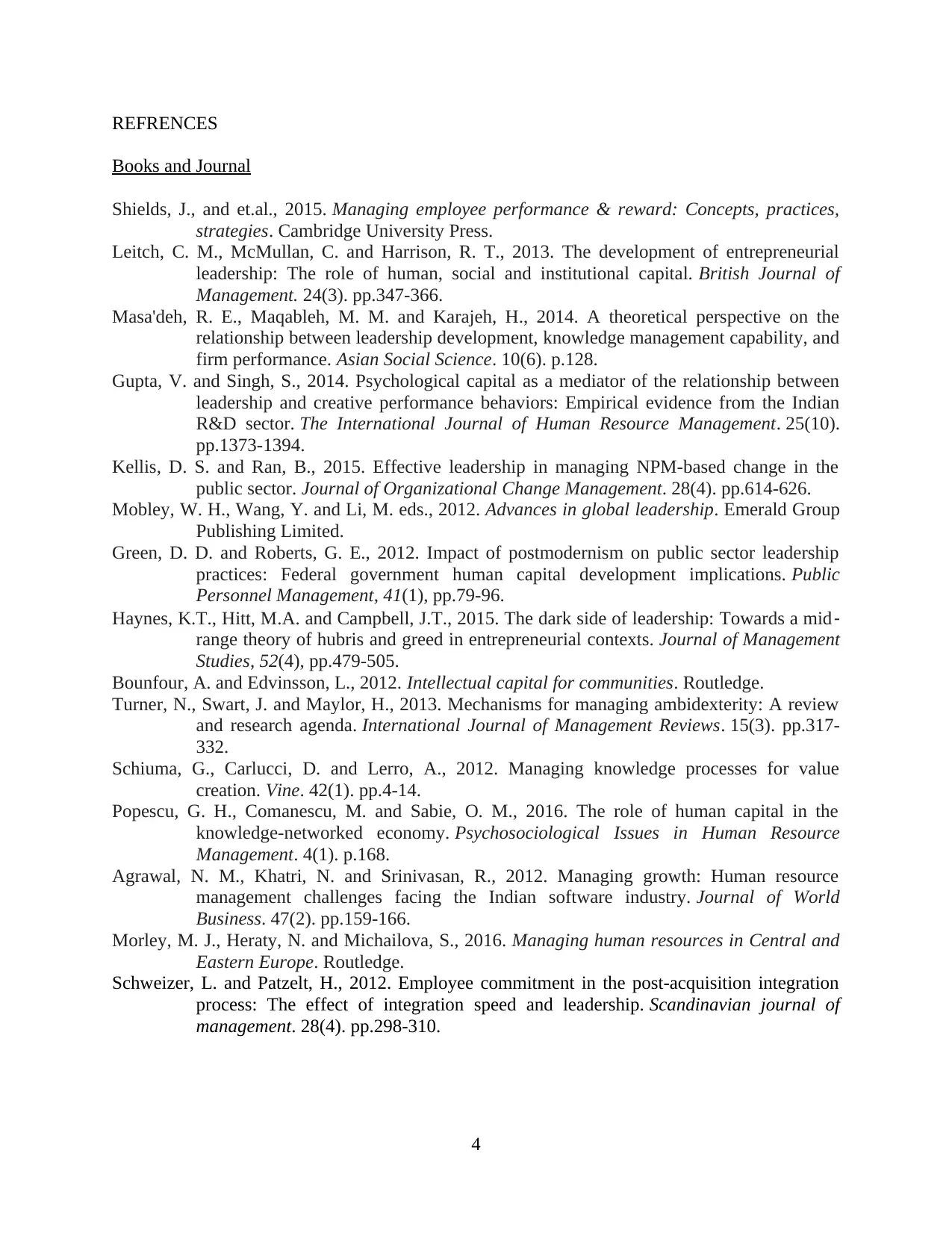
REFRENCES
Books and Journal
Shields, J., and et.al., 2015. Managing employee performance & reward: Concepts, practices,
strategies. Cambridge University Press.
Leitch, C. M., McMullan, C. and Harrison, R. T., 2013. The development of entrepreneurial
leadership: The role of human, social and institutional capital. British Journal of
Management. 24(3). pp.347-366.
Masa'deh, R. E., Maqableh, M. M. and Karajeh, H., 2014. A theoretical perspective on the
relationship between leadership development, knowledge management capability, and
firm performance. Asian Social Science. 10(6). p.128.
Gupta, V. and Singh, S., 2014. Psychological capital as a mediator of the relationship between
leadership and creative performance behaviors: Empirical evidence from the Indian
R&D sector. The International Journal of Human Resource Management. 25(10).
pp.1373-1394.
Kellis, D. S. and Ran, B., 2015. Effective leadership in managing NPM-based change in the
public sector. Journal of Organizational Change Management. 28(4). pp.614-626.
Mobley, W. H., Wang, Y. and Li, M. eds., 2012. Advances in global leadership. Emerald Group
Publishing Limited.
Green, D. D. and Roberts, G. E., 2012. Impact of postmodernism on public sector leadership
practices: Federal government human capital development implications. Public
Personnel Management, 41(1), pp.79-96.
Haynes, K.T., Hitt, M.A. and Campbell, J.T., 2015. The dark side of leadership: Towards a mid‐
range theory of hubris and greed in entrepreneurial contexts. Journal of Management
Studies, 52(4), pp.479-505.
Bounfour, A. and Edvinsson, L., 2012. Intellectual capital for communities. Routledge.
Turner, N., Swart, J. and Maylor, H., 2013. Mechanisms for managing ambidexterity: A review
and research agenda. International Journal of Management Reviews. 15(3). pp.317-
332.
Schiuma, G., Carlucci, D. and Lerro, A., 2012. Managing knowledge processes for value
creation. Vine. 42(1). pp.4-14.
Popescu, G. H., Comanescu, M. and Sabie, O. M., 2016. The role of human capital in the
knowledge-networked economy. Psychosociological Issues in Human Resource
Management. 4(1). p.168.
Agrawal, N. M., Khatri, N. and Srinivasan, R., 2012. Managing growth: Human resource
management challenges facing the Indian software industry. Journal of World
Business. 47(2). pp.159-166.
Morley, M. J., Heraty, N. and Michailova, S., 2016. Managing human resources in Central and
Eastern Europe. Routledge.
Schweizer, L. and Patzelt, H., 2012. Employee commitment in the post-acquisition integration
process: The effect of integration speed and leadership. Scandinavian journal of
management. 28(4). pp.298-310.
4
Books and Journal
Shields, J., and et.al., 2015. Managing employee performance & reward: Concepts, practices,
strategies. Cambridge University Press.
Leitch, C. M., McMullan, C. and Harrison, R. T., 2013. The development of entrepreneurial
leadership: The role of human, social and institutional capital. British Journal of
Management. 24(3). pp.347-366.
Masa'deh, R. E., Maqableh, M. M. and Karajeh, H., 2014. A theoretical perspective on the
relationship between leadership development, knowledge management capability, and
firm performance. Asian Social Science. 10(6). p.128.
Gupta, V. and Singh, S., 2014. Psychological capital as a mediator of the relationship between
leadership and creative performance behaviors: Empirical evidence from the Indian
R&D sector. The International Journal of Human Resource Management. 25(10).
pp.1373-1394.
Kellis, D. S. and Ran, B., 2015. Effective leadership in managing NPM-based change in the
public sector. Journal of Organizational Change Management. 28(4). pp.614-626.
Mobley, W. H., Wang, Y. and Li, M. eds., 2012. Advances in global leadership. Emerald Group
Publishing Limited.
Green, D. D. and Roberts, G. E., 2012. Impact of postmodernism on public sector leadership
practices: Federal government human capital development implications. Public
Personnel Management, 41(1), pp.79-96.
Haynes, K.T., Hitt, M.A. and Campbell, J.T., 2015. The dark side of leadership: Towards a mid‐
range theory of hubris and greed in entrepreneurial contexts. Journal of Management
Studies, 52(4), pp.479-505.
Bounfour, A. and Edvinsson, L., 2012. Intellectual capital for communities. Routledge.
Turner, N., Swart, J. and Maylor, H., 2013. Mechanisms for managing ambidexterity: A review
and research agenda. International Journal of Management Reviews. 15(3). pp.317-
332.
Schiuma, G., Carlucci, D. and Lerro, A., 2012. Managing knowledge processes for value
creation. Vine. 42(1). pp.4-14.
Popescu, G. H., Comanescu, M. and Sabie, O. M., 2016. The role of human capital in the
knowledge-networked economy. Psychosociological Issues in Human Resource
Management. 4(1). p.168.
Agrawal, N. M., Khatri, N. and Srinivasan, R., 2012. Managing growth: Human resource
management challenges facing the Indian software industry. Journal of World
Business. 47(2). pp.159-166.
Morley, M. J., Heraty, N. and Michailova, S., 2016. Managing human resources in Central and
Eastern Europe. Routledge.
Schweizer, L. and Patzelt, H., 2012. Employee commitment in the post-acquisition integration
process: The effect of integration speed and leadership. Scandinavian journal of
management. 28(4). pp.298-310.
4
⊘ This is a preview!⊘
Do you want full access?
Subscribe today to unlock all pages.

Trusted by 1+ million students worldwide
1 out of 6
Related Documents
Your All-in-One AI-Powered Toolkit for Academic Success.
+13062052269
info@desklib.com
Available 24*7 on WhatsApp / Email
![[object Object]](/_next/static/media/star-bottom.7253800d.svg)
Unlock your academic potential
Copyright © 2020–2025 A2Z Services. All Rights Reserved. Developed and managed by ZUCOL.





